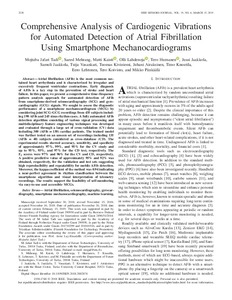Comprehensive Analysis of Cardiogenic Vibrations for Automated Detection of Atrial Fibrillation Using Smartphone Mechanocardiograms
Mojtaba Jafari Tadi; Saeed Mehrang; Matti Kaisti; Olli Lahdenoja; Tero Hurnanen; Jussi Jaakkola; Samuli Jaakkola; Tuija Vasankari; Tuomas Kiviniemi; Juhani Airaksinen; Timo Knuutila; Eero Lehtonen; Tero Koivisto; Mikko Pänkäälä
https://urn.fi/URN:NBN:fi-fe2021042720392
Tiivistelmä
Atrial fibrillation (AFib) is the most common sustained heart arrhythmia and is characterized by irregular and excessively frequent ventricular contractions. Early diagnosis of AFib is a key step in the prevention of stroke and heart failure. In this study, we present a comprehensive time-frequency pattern analysis approach for automated detection of AFib from smartphone-derived seismocardiography (SCG) and gyrocardiography (GCG) signals. We sought to assess the diagnostic performance of a smartphone mechanocardiogram (MCG) by considering joint SCG-GCG recordings from 435 subjects including 190 AFib and 245 sinus rhythm (SR) cases. A fully automated AFib detection algorithm consisting of various signal processing and multidisciplinary feature engineering techniques was developed and evaluated through a large set of cross-validation (CV) data including 300 (AFib=150) cardiac patients. The trained model was further tested on an unseen set of recordings including 135 (AFib=40) subjects considered as cross-database (CD). The experimental results showed accuracy, sensitivity, and specificity of approximately 97%, 99%, and 95% for the CV study and up to 95%, 93%, and 97% for the CD test, respectively. The F1 scores were 97% and 96% for the CV and CD, respectively. A positive predictive value of approximately 95% and 92% was obtained respectively for the validation and test sets suggesting high reproducibility and repeatability for mobile AFib detection. Moreover, the kappa coefficient of the method was 0.94 indicating a near-perfect agreement in rhythm classification between the smartphone algorithm and visual interpretation of telemetry recordings. The results support the feasibility of self-monitoring via easy-to-use and accessible MCGs.
Kokoelmat
- Rinnakkaistallenteet [27094]
